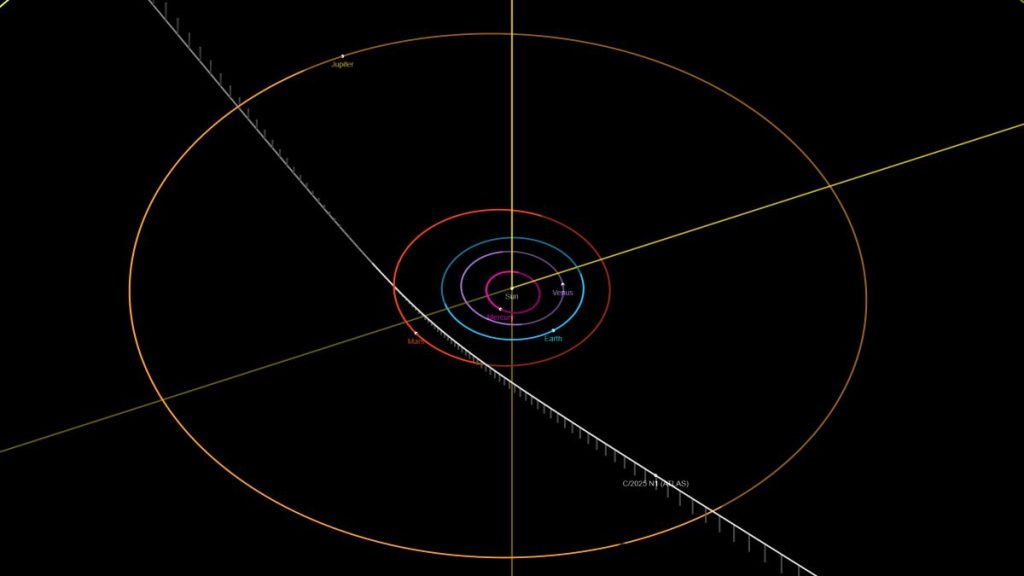They appear suddenly, crossing the Solar System before vanishing back into deep space.
Others are reading now
These rare travelers are fragments from other stars, carrying clues about distant worlds far beyond our reach.
A handful of strangers
Only three confirmed interstellar objects have ever passed through our Solar System: the asteroid Oumuamua and the comets 2I/Borisov and 3I/ATLAS.
Out of an estimated one octillion interstellar objects drifting through the galaxy, these are the only ones we have seen.
Oumuamua, discovered in 2017, caused a stir with its strange shape and movement. Some speculated it might be an alien spacecraft.
Scientists, however, concluded it was most likely a natural fragment of rock or ice flung from another star system.
Also read
2I/Borisov and 3I/ATLAS were found soon after.
Their chemistry proved different from anything else in the Solar System, confirming that they were true visitors from beyond the Sun.
A galaxy of debris
Stars in the Milky Way eject immense amounts of material over their lifetimes, roughly 10 quadrillion objects per system.
Most are expelled during the chaotic early stages of planet formation or pulled away later by passing stars.
These particles spread into long, tangled streams as they move through the galaxy. Because of this, tracing any one interstellar visitor back to its home star is nearly impossible.
Also read
Astronomers estimate that Oumuamua came from somewhere within 3,000 light-years of Earth, but the exact star remains unknown.
With hundreds of future detections, scientists hope to find “siblings” that share a common origin, revealing their source more precisely.
Finding the wanderers
Despite only three confirmed so far, many more are likely passing by unnoticed.
Astronomers think about 60 interstellar objects move within Jupiter’s orbit at any given time, along with several that may stay bound to the Sun.
Most are too dim to detect unless they approach Earth closely. The Vera C. Rubin Observatory in Chile and NASA’s NEO Surveyor space telescope, planned for launch in 2027, are designed to change that.
Also read
Together, these observatories could identify up to 70 new interstellar objects each year, depending on how reflective such bodies are.
Even a smaller number would vastly expand what we know about material from other stars.
Windows into other worlds
Every new interstellar object offers a glimpse into another planetary system.
By examining their composition and motion, scientists can learn how planets form, shift, and sometimes get cast adrift.
Some researchers believe these travelers may even help build new planets.
Also read
When one drifts into a young system, it could act as a seed for accumulating dust and gas, starting the process of planet formation.
Others suggest collisions between interstellar debris and neutron stars might explain brief, powerful fast radio bursts.
The Sun itself is thought to be struck by an interstellar object roughly once every 60 years.
Reaching the visitors
A mission to an interstellar object would let humanity study another star system without leaving our own.
Spacecraft could sample its surface or fly through its tail to analyze what it is made of.
Also read
Timing is critical, since these objects move quickly and leave the inner Solar System within months.
One proposal is to keep a spacecraft ready to launch immediately after discovery, though maintaining such readiness would be costly.
Another idea is to station a small probe in orbit around the Sun or Earth. When a target appears, the probe would accelerate to intercept it.
The European Space Agency plans a mission of this kind in 2029 to study a regular comet, but if an interstellar object passes nearby, it could be redirected for a closer look.
The Planetary Society’s LightSail missions, which proved that solar sails can propel spacecraft using sunlight alone, could be key to such efforts.
Also read
These technologies may one day allow us to explore a fragment of another world, without leaving our own.


